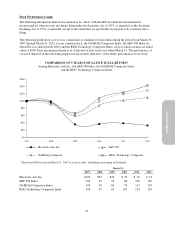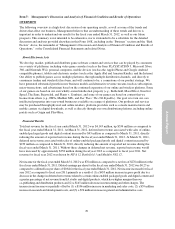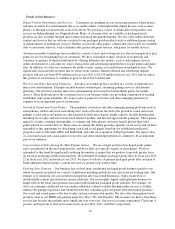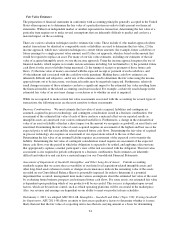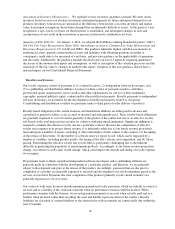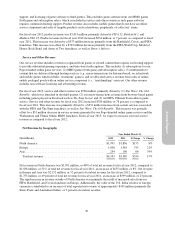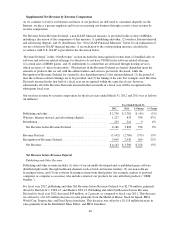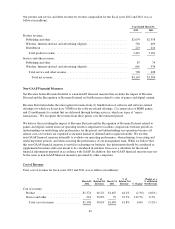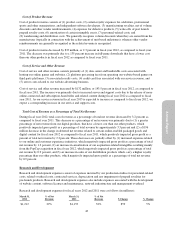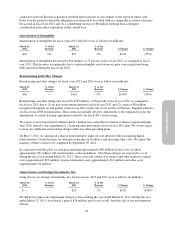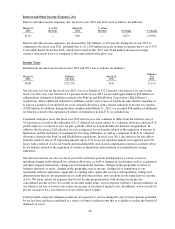Electronic Arts 2012 Annual Report Download - page 121
Download and view the complete annual report
Please find page 121 of the 2012 Electronic Arts annual report below. You can navigate through the pages in the report by either clicking on the pages listed below, or by using the keyword search tool below to find specific information within the annual report.
Annual Report
Each quarter, we also evaluate the expected future realization of our royalty-based assets, as well as any
unrecognized minimum commitments not yet paid to determine amounts we deem unlikely to be realized through
product sales. Any impairments or losses determined before the launch of a product are charged to research and
development expense. Impairments or losses determined post-launch are charged to cost of revenue. We evaluate
long-lived royalty-based assets for impairment generally using undiscounted cash flows when impairment
indicators exist. Unrecognized minimum royalty-based commitments are accounted for as executory contracts,
and therefore, any losses on these commitments are recognized when the underlying intellectual property is
abandoned (i.e., cease use) or the contractual rights to use the intellectual property are terminated.
Income Taxes
We recognize deferred tax assets and liabilities for both the expected impact of differences between the financial
statement amount and the tax basis of assets and liabilities and for the expected future tax benefit to be derived
from tax losses and tax credit carry forwards. We record a valuation allowance against deferred tax assets when it
is considered more likely than not that all or a portion of our deferred tax assets will not be realized. In making
this determination, we are required to give significant weight to evidence that can be objectively verified. It is
generally difficult to conclude that a valuation allowance is not needed when there is significant negative
evidence, such as cumulative losses in recent years. Forecasts of future taxable income are considered to be less
objective than past results, particularly in light of the economic environment. Therefore, cumulative losses weigh
heavily in the overall assessment.
In addition to considering forecasts of future taxable income, we are also required to evaluate and quantify other
possible sources of taxable income in order to assess the realization of our deferred tax assets, namely the
reversal of existing deferred tax liabilities, the carry back of losses and credits as allowed under current tax law,
and the implementation of tax planning strategies. Evaluating and quantifying these amounts involves significant
judgments. Each source of income must be evaluated based on all positive and negative evidence; this evaluation
involves assumptions about future activity. Certain taxable temporary differences that are not expected to reverse
during the carry forward periods permitted by tax law cannot be considered as a source of future taxable income
that may be available to realize the benefit of deferred tax assets.
Based on the assumptions and requirements noted above, we have recorded a valuation allowance against most of
our U.S. deferred tax assets. In addition, we expect to provide a valuation allowance on future U.S. tax benefits
until we can sustain a level of profitability or until other significant positive evidence arises that suggest that
these benefits are more likely than not to be realized.
In the ordinary course of our business, there are many transactions and calculations where the tax law and
ultimate tax determination is uncertain. As part of the process of preparing our Consolidated Financial
Statements, we are required to estimate our income taxes in each of the jurisdictions in which we operate prior to
the completion and filing of tax returns for such periods. This process requires estimating both our geographic
mix of income and our uncertain tax positions in each jurisdiction where we operate. These estimates involve
complex issues and require us to make judgments about the likely application of the tax law to our situation, as
well as with respect to other matters, such as anticipating the positions that we will take on tax returns prior to
our actually preparing the returns and the outcomes of disputes with tax authorities. The ultimate resolution of
these issues may take extended periods of time due to examinations by tax authorities and statutes of limitations.
In addition, changes in our business, including acquisitions, changes in our international corporate structure,
changes in the geographic location of business functions or assets, changes in the geographic mix and amount of
income, as well as changes in our agreements with tax authorities, valuation allowances, applicable accounting
rules, applicable tax laws and regulations, rulings and interpretations thereof, developments in tax audit and other
matters, and variations in the estimated and actual level of annual pre-tax income can affect the overall effective
income tax rate.
We historically have considered undistributed earnings of our foreign subsidiaries to be indefinitely reinvested
outside of the United States, and accordingly, no U.S. taxes have been provided thereon. We currently intend to
continue to indefinitely reinvest the undistributed earnings of our foreign subsidiaries outside of the United States.
37


